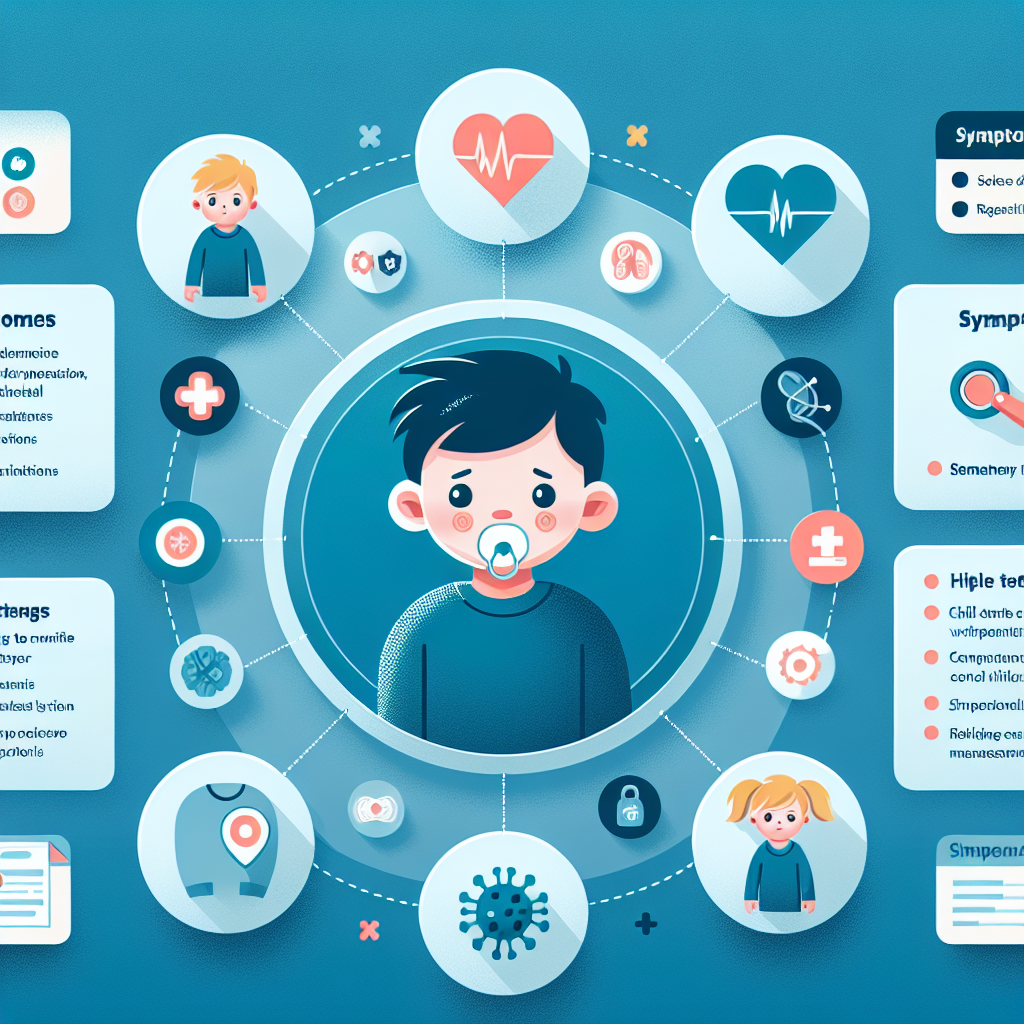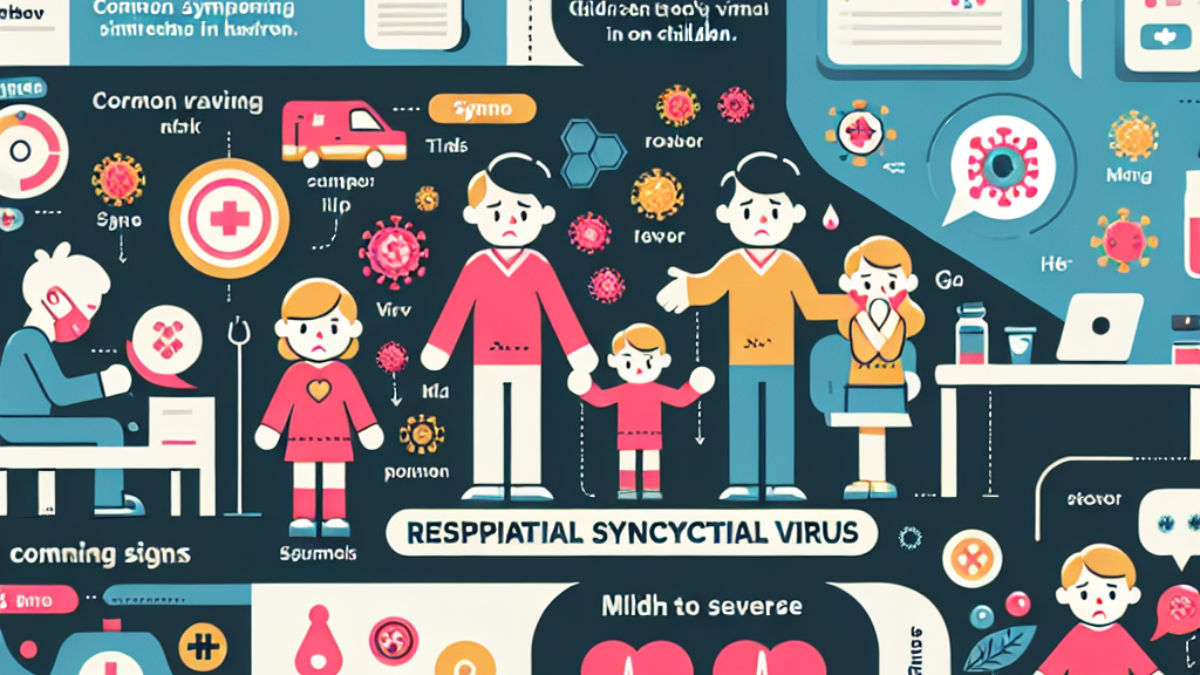In this article, you will gain valuable insights into the common symptoms of Respiratory Syncytial Virus (RSV) in children. RSV is a highly contagious viral infection that affects the respiratory system, particularly in infants and young children. By understanding the telltale signs and symptoms, parents and caregivers can identify RSV early on and seek appropriate medical care for their little ones. By focusing on the symptoms, we aim to equip you with the necessary knowledge to safeguard your child’s health and well-being.

Understanding RSV
RSV, which stands for Respiratory Syncytial Virus, is a common viral infection that primarily affects the respiratory system. It is a leading cause of respiratory illnesses such as bronchiolitis and pneumonia in infants and young children. RSV can affect individuals of all ages, but the severity of symptoms and the risk of complications are generally higher in infants and children with pre-existing medical conditions.
What is RSV?
RSV is a highly contagious virus that spreads through respiratory droplets, making it easy for it to be transmitted from person to person. It is typically more prevalent during the fall, winter, and early spring months. While most cases of RSV result in mild cold-like symptoms, it can lead to severe respiratory distress and hospitalization, especially in young children and individuals with weakened immune systems.
How common is RSV?
RSV is extremely common, with nearly all children having been infected by the virus at least once by the time they reach the age of two. It is estimated that more than 2 million children under the age of five in the United States require medical attention for RSV each year. Due to its high rate of transmission and the potential for severe illness, RSV is a significant public health concern, especially in pediatric populations.
How is RSV spread?
RSV is primarily spread through respiratory droplets when an infected person coughs or sneezes. It can also be contracted by touching surfaces or objects contaminated with the virus and then touching the face, particularly the eyes, nose, or mouth. Medical professionals believe that RSV can survive on surfaces for several hours, making it important to maintain proper hygiene and sanitation practices to prevent its spread.
Early signs of RSV
Recognizing the early signs of RSV is crucial in preventing its spread and ensuring prompt medical intervention. While the severity of symptoms can vary, there are common indicators to watch out for.
Incubation period of RSV
After exposure to RSV, it typically takes around 4 to 6 days for symptoms to develop. During this incubation period, an individual may not experience any noticeable signs of infection, making it challenging to identify RSV transmission early on.
Mild cold-like symptoms
In most cases, RSV initially presents as mild cold-like symptoms, including a runny or stuffy nose, sneezing, mild cough, and low-grade fever. These symptoms can easily be mistaken for a common cold or seasonal allergies, leading to delayed diagnosis and potential spread of the virus.
Decreased appetite
Another early sign of RSV in children is a decrease in appetite. Infants and children infected with RSV may show a reduced interest in breastfeeding or bottle feeding and may have difficulty staying hydrated. It is important to monitor their fluid intake to prevent dehydration, especially in younger infants.
Respiratory symptoms
As RSV progresses, it can cause various respiratory symptoms indicative of more severe illness.
Cough
A persistent cough is a common symptom of RSV and can become increasingly severe as the infection progresses. The cough may be accompanied by wheezing or a whistling sound during exhalation.
Wheezing
Wheezing, which is a high-pitched whistling sound produced during breathing, is a significant respiratory symptom of RSV. It occurs when the airways become narrowed or blocked, making it difficult for the individual to breathe properly. Wheezing may be more pronounced in younger children and can be a sign of more severe RSV infection.
Difficulty in breathing
RSV can cause marked breathing difficulties, especially in infants and younger children. Rapid, shallow breathing, increased respiratory rate, and retractions (visible sinking of the chest between the ribs or under the ribcage) may indicate severe respiratory distress and the need for immediate medical attention.
Rapid breathing or apnea in infants
In some cases, RSV can lead to rapid or irregular breathing patterns in infants, which may be accompanied by brief pauses in breathing known as apnea. These signs should never be ignored, and immediate medical attention should be sought to evaluate and manage the respiratory distress.

Systemic symptoms
RSV can also cause systemic symptoms, which affect the entire body and may present alongside respiratory symptoms.
Fever
Fever is a prevalent systemic symptom of RSV. While it can vary in intensity, a persistently high fever (above 100.4°F or 38°C) may indicate a more severe infection and should be monitored closely.
Irritability
Children with RSV may exhibit increased irritability, restlessness, or fussiness. This may be due to the discomfort caused by respiratory symptoms, fatigue, or overall illness. Caregivers should provide a calm and supportive environment to help soothe the child during this time.
Fatigue or Lethargy
RSV can cause significant fatigue or lethargy, especially in young children. They may appear weak, listless, or excessively sleepy. It is crucial to ensure they rest adequately to facilitate their recovery and prevent complications.
RSV in infants
RSV poses a particular risk to infants, particularly those under six months of age, due to their underdeveloped immune systems and narrower airways.
Significance of RSV in infants
RSV is the leading cause of bronchiolitis and pneumonia in infants, often resulting in hospitalization. Infants who experience severe RSV infection may require intensive medical intervention, including supplemental oxygen and respiratory support.
Severity of symptoms in infants vs. older children
The symptoms of RSV in infants can be more severe compared to older children or adults. Infants may show significant respiratory distress, including tachypnea (rapid breathing), retractions, grunting sounds during breathing, and cyanosis (bluish discoloration of the skin or lips), indicating a lack of oxygen in the blood.
Cyanosis in infants
One of the alarming signs of severe RSV infection in infants is cyanosis. This bluish discoloration of the skin or lips is indicative of inadequate oxygen levels in the bloodstream and requires immediate medical attention.
RSV in older children
While RSV is more commonly associated with severe illness in infants, older children can also be affected, albeit with milder symptoms.
Typical course of illness in older children
In older children, RSV infection tends to resemble a typical upper respiratory tract infection. They may experience nasal congestion, cough, and low-grade fever. These symptoms generally resolve within a week or two without severe complications.
Duration of symptoms
The duration of RSV symptoms in older children is generally shorter compared to infants. Most older children recover fully within 7-14 days without requiring medical intervention.
Recurrence of RSV
Although it is uncommon, individuals can be reinfected with RSV after recovering from a previous infection. However, subsequent infections typically result in milder symptoms compared to the initial infection.
Complications of RSV
RSV can lead to various complications, especially in vulnerable populations such as infants and children with pre-existing medical conditions.
Bronchiolitis
Bronchiolitis, characterized by inflammation and congestion of the small airways in the lungs, is one of the most common complications of RSV in infants. It can cause breathing difficulties, wheezing, and decreased oxygen levels, necessitating hospitalization and supportive care.
Pneumonia
RSV pneumonia can occur when the virus spreads to the lungs, leading to inflammation and infection. Pneumonia can cause severe respiratory distress and requires medical intervention to manage and treat the infection effectively.
Middle ear infection
RSV can also increase the risk of middle ear infections, known as otitis media. This occurs due to the spread of the virus to the middle ear, leading to symptoms such as pain, ear discharge, and temporary hearing loss.
RSV in children with pre-existing conditions
Children with underlying medical conditions, such as chronic lung disease, congenital heart disease, or weakened immune systems, are at a higher risk of developing severe RSV disease. It is crucial for these children to receive timely medical attention and preventative measures to minimize the risk of complications.
When to seek medical attention
Prompt medical attention is necessary when dealing with RSV, particularly in infants and children experiencing severe symptoms.
Severity of symptoms to look out for
Parents and caregivers should closely monitor for severe symptoms such as rapid breathing, retractions, difficulty in feeding or drinking, and extreme lethargy. These signs may indicate an acute respiratory emergency and require immediate medical intervention.
RSV emergency symptoms
Certain emergency symptoms associated with RSV should never be ignored. Persistent bluish coloration of the lips, extreme difficulty in breathing, or a sudden change in alertness or responsiveness demand urgent medical attention.
Monitoring of symptoms at home
While mild cases of RSV can be managed at home, it is essential to monitor the child’s symptoms carefully. Regularly check their temperature, observe their breathing patterns, and ensure they are staying well-hydrated. If the symptoms worsen or fail to improve within a few days, consult a healthcare professional for further evaluation and guidance.
Diagnosis of RSV
The diagnosis of RSV is typically based on a combination of factors, including physical examination, medical history, and laboratory tests.
Physical examination
During a physical examination, healthcare providers will evaluate the child’s respiratory distress, lung sounds, and overall clinical presentation. This helps them assess the severity of symptoms and determine the most appropriate course of treatment.
Medical history
The child’s medical history plays a crucial role in diagnosing RSV. The healthcare provider may inquire about recent exposures to individuals with respiratory infections, the duration and progression of symptoms, and the presence of any underlying medical conditions.
Lab tests for RSV detection
Laboratory tests, such as rapid antigen testing or polymerase chain reaction (PCR) testing, can confirm the presence of RSV. These tests involve collecting a nasal or throat swab to detect viral genetic material or proteins. The results of these tests help guide healthcare providers in providing appropriate treatment and infection control measures.
Prevention of RSV
Preventing the spread of RSV is vital to protect vulnerable populations, particularly infants and children at higher risk of severe illness.
Hand hygiene
Proper hand hygiene is crucial in preventing the transmission of RSV. Regularly wash your hands with soap and water for at least 20 seconds, especially after being in close contact with someone who is sick or frequently touched surfaces.
Cough and sneeze etiquette
Encouraging proper cough and sneeze etiquette is an effective way to prevent the spread of RSV. Teach children to cover their mouth and nose with a tissue or the crook of their elbow when coughing or sneezing, and dispose of tissues properly after use.
Avoid close contact with infected individuals
Limiting close contact with individuals who have respiratory symptoms or diagnosed RSV infections is crucial in preventing transmission. Keep infants away from sick individuals and ensure that older children or adults with RSV practice good respiratory hygiene.
Vaccination
While there is currently no vaccine available for RSV, ongoing research is being conducted to develop an effective vaccine to prevent severe RSV infections in high-risk populations, such as infants and older adults. It is important to stay informed about the latest developments regarding RSV vaccination.
Preventive measures in healthcare settings
Healthcare facilities play a vital role in preventing the spread of RSV. Implementing infection control measures, such as regular hand hygiene, appropriate use of personal protective equipment, and isolation precautions, can significantly reduce the risk of RSV transmission within healthcare settings.
In conclusion, understanding RSV and recognizing its symptoms is crucial in preventing its spread and ensuring prompt medical intervention. RSV can cause mild to severe respiratory symptoms, particularly in infants and young children, and increase the risk of complications such as bronchiolitis and pneumonia. If you suspect your child may have RSV, it is important to seek medical attention and follow preventive measures to protect vulnerable individuals and reduce the impact of RSV on public health.

